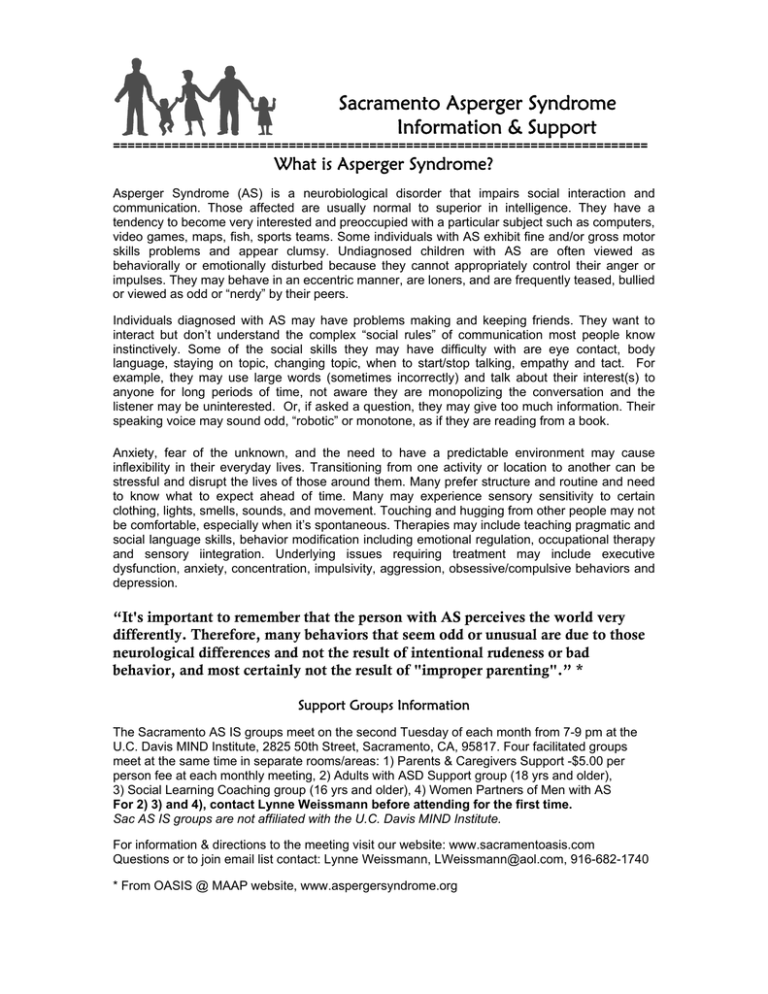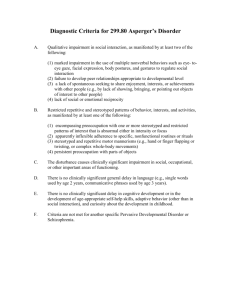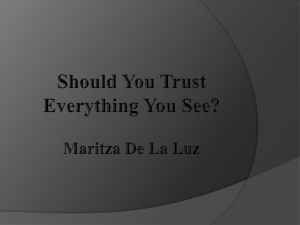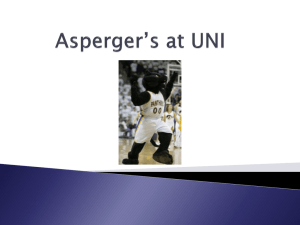Sacramento Asperger Syndrome Information & Support What is Asperger Syndrome?
advertisement

Sacramento Asperger Syndrome Information & Support ========================================================================= What is Asperger Syndrome? Asperger Syndrome (AS) is a neurobiological disorder that impairs social interaction and communication. Those affected are usually normal to superior in intelligence. They have a tendency to become very interested and preoccupied with a particular subject such as computers, video games, maps, fish, sports teams. Some individuals with AS exhibit fine and/or gross motor skills problems and appear clumsy. Undiagnosed children with AS are often viewed as behaviorally or emotionally disturbed because they cannot appropriately control their anger or impulses. They may behave in an eccentric manner, are loners, and are frequently teased, bullied or viewed as odd or “nerdy” by their peers. Individuals diagnosed with AS may have problems making and keeping friends. They want to interact but don’t understand the complex “social rules” of communication most people know instinctively. Some of the social skills they may have difficulty with are eye contact, body language, staying on topic, changing topic, when to start/stop talking, empathy and tact. For example, they may use large words (sometimes incorrectly) and talk about their interest(s) to anyone for long periods of time, not aware they are monopolizing the conversation and the listener may be uninterested. Or, if asked a question, they may give too much information. Their speaking voice may sound odd, “robotic” or monotone, as if they are reading from a book. Anxiety, fear of the unknown, and the need to have a predictable environment may cause inflexibility in their everyday lives. Transitioning from one activity or location to another can be stressful and disrupt the lives of those around them. Many prefer structure and routine and need to know what to expect ahead of time. Many may experience sensory sensitivity to certain clothing, lights, smells, sounds, and movement. Touching and hugging from other people may not be comfortable, especially when it’s spontaneous. Therapies may include teaching pragmatic and social language skills, behavior modification including emotional regulation, occupational therapy and sensory iintegration. Underlying issues requiring treatment may include executive dysfunction, anxiety, concentration, impulsivity, aggression, obsessive/compulsive behaviors and depression. “It's important to remember that the person with AS perceives the world very differently. Therefore, many behaviors that seem odd or unusual are due to those neurological differences and not the result of intentional rudeness or bad behavior, and most certainly not the result of "improper parenting".” * Support Groups Information The Sacramento AS IS groups meet on the second Tuesday of each month from 7-9 pm at the U.C. Davis MIND Institute, 2825 50th Street, Sacramento, CA, 95817. Four facilitated groups meet at the same time in separate rooms/areas: 1) Parents & Caregivers Support -$5.00 per person fee at each monthly meeting, 2) Adults with ASD Support group (18 yrs and older), 3) Social Learning Coaching group (16 yrs and older), 4) Women Partners of Men with AS For 2) 3) and 4), contact Lynne Weissmann before attending for the first time. Sac AS IS groups are not affiliated with the U.C. Davis MIND Institute. For information & directions to the meeting visit our website: www.sacramentoasis.com Questions or to join email list contact: Lynne Weissmann, LWeissmann@aol.com, 916-682-1740 * From OASIS @ MAAP website, www.aspergersyndrome.org Diagnostic Criteria for 299.80 Asperger's Disorder from DSM IV-TR (2000) A. Qualitative impairment in social interaction, as manifested by at least two of the following: 1. marked impairment in the use of multiple nonverbal behaviors such as eye-to eye gaze, facial expression, body postures, and gestures to regulate social interaction 2. failure to develop peer relationships appropriate to developmental level 3. a lack of spontaneous seeking to share enjoyment, interests, or achievements with other people (e.g., by a lack of showing, bringing, or pointing out objects of interest to other people) 4. lack of social or emotional reciprocity B. Restricted repetitive and stereotyped patterns of behavior, interests and activities, as manifested by at least one of the following: 1. encompassing preoccupation with one or more stereotyped and restricted patterns of interest that is abnormal either in intensity of focus 2. apparently inflexible adherence to specific, nonfunctional routines or rituals 3. stereotyped and repetitive motor mannerisms (e.g., hand or finger flapping or twisting, or complex whole-body movements) 4. persistent preoccupation with parts of objects C. The disturbance causes clinically significant impairment in social, occupational, or other important areas of functioning. D. There is no clinically significant general delay in language (e.g., single words used by age 2 years, communicative phrases used by age 3 years). E. There is no clinically significant delay in cognitive development or in the development of age-appropriate self-help skills, adaptive behavior (other than in social interaction), and curiosity about the environment in childhood. F. Criteria are not met for another specific Pervasive Developmental Disorder or Schizophrenia.



![ )] (](http://s2.studylib.net/store/data/010418727_1-2ddbdc186ff9d2c5fc7c7eee22be7791-300x300.png)